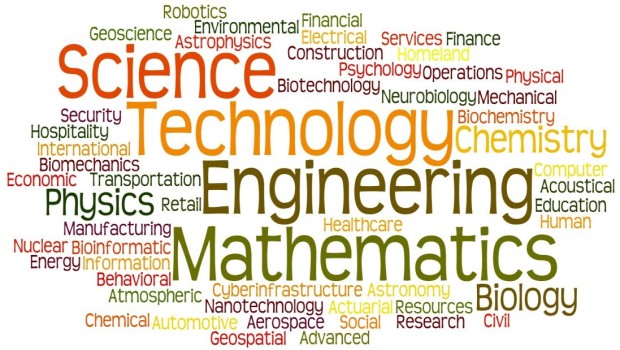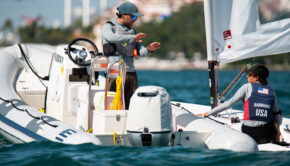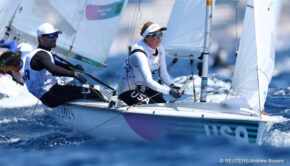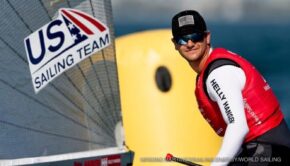Bringing Science and Engineering to Kids
Published on November 21st, 2013
“All sailing is really about science and math,” says John O’Flaherty, executive director of Community Boating Center in Providence, RI.
“You’re immersed in it, whether you realize it or not.” To capitalize on that connection, the boating center teamed up with Providence After School Alliance to tie what kids experience on the water to what they’re doing in science and math at school.
Together, they developed a summer program for middle-school students that involved two days in the classroom and two days on the water. “We added a very under-toned dash of science to the sailing,” O’Flaherty says. “The next day in class, the teacher used the on-water experience as a springboard for discussion of the science behind it.”
Teachers found that students were much more interested in learning about science when they had a stake in it. “There’s a certain magic to sailing,” O’Flaherty says. “If you learn the lessons, you get to harness these invisible forces – wind, currents, tides – and use them to go fast, which is fun and exciting.”
Hull shape, sail size, tillers and pulleys created opportunities to include physics, math and engineering into the learning experience, as well as wind, weather and waterway science.
The summer program was so well received that O’Flaherty asked US Sailing to help develop a formal curriculum. US Sailing was enthusiastic. They hired Jessica Servis, an experienced sailor and a teacher with a master’s in education, to be program manager for what came to be called REACH.
“Sailing is like sticking kids in a real-life interactive lab every day,” Servis says. “Everyone knew it had a great STEM (Science, Technology, Engineering and Mathematics) connection, but there was no curriculum that spoke to teachers and schools, met education frameworks, and could be implemented by a community-sailing center.”
After three years of development, REACH launched in June 2012 with 10 modules, each built on inquiry-based learning and engineering-by-design principles. The goal: to provide hands-on integrated learning opportunities that inspire interest in physics, marine biology, robotics, technology and more.
To actively involve students, each lesson takes an investigative approach and is built around answering questions such as: How does this boat float? What shape are sails and why? How does marine debris get in our waters and where does it go? Why does the wind change as the day progresses?
Katie Schlotterbeck, a middle-school science teacher at St. Michael Lutheran, a National Blue Ribbon School in Fort Myers, Florida, was part of the five-site pilot REACH program. “The curriculum is very flexible,” she says. “It’s also easy to teach. You don’t have to make the topics exciting – they’re already exciting for students.”
Schlotterbeck likes that the modules are inquiry based. “Too many times, students are given a set of directions to follow,” she says. “I like to say, ‘Here’s the question, now how can you solve it?’ They’ll draw, test, and come back to the drawing board until they get their answer. We need to teach students how to solve problems, not just how to follow directions.”
For each REACH module there are in-classroom and on-water activities that teach the same concepts. “Our philosophy is to let experts do what they do best,” says Servis. “Let sailing schools get kids on the water and do those parts of the lesson, and have teachers do pre-teaching, follow-up activities, and post-discussion of what was learned on the water.”
Sailing and STEM are being connected on a more informal basis, too. During the recent America’s Cup racing in San Francisco, the connection was leveraged by sailors from the American Youth Sailing Force, a team that competed in the youth version of the America’s Cup, held concurrently.
“We wanted to use our position, our team, and the excitement of the America’s Cup to show kids how the math and science they learn in school are applied in real life,” says 22-year-old Ian Andrewes, Force team member and manager.
The Force worked with schools and sailing programs in the Bay Area. “Getting kids out sailing is the most important thing,” Andrewes says. “As a sailor, part of your job is to understand things like rigging load and structural dynamics. You end up dealing with a bit of everything. Basically, we wanted to help kids realize what’s available to them if they’re just willing to step outside their comfort zone.”
The REACH program and others like it continue to grow in popularity. In its first year, more than 70 schools, sailing centers and youth programs purchased the REACH curriculum (REACH Educator Guide $59.95). Fifteen of those groups are already using REACH for ongoing programming.
“REACH empowers kids to control their own learning environment and encourages them to ask questions, then come up with answers,” O’Flaherty says.
“For most kids, it’s the first time someone has trusted them with something as expensive as a sailboat and let them be the captain. When they realize they’re in control of it with nothing but simple machinery, it’s a real eye-opener. You see the smiles come out the first day we get kids in the boats.”
Source: PTC.com









 We’ll keep your information safe.
We’ll keep your information safe.